-
CATEGORY ::
- All Seeds /
- All Flower Seeds /
- All Hollyhock Seeds





Hollyhock Seeds - Zebrina
SEASON
Perennial
USDA ZONES
5 - 9
HEIGHT
48 inches
BLOOM SEASON
Summer
BLOOM COLOR
White and purple
ENVIRONMENT
Full sun to partial shade
SOIL TYPE
Well-drained, pH 5.8 - 7.2
DEER RESISTANT
Yes
HOUSE PLANT
No
SEASON
Annual
USDA ZONES
3 - 9
HEIGHT
48 - 72 inches
BLOOM SEASON
Summer
BLOOM COLOR
Mix
ENVIRONMENT
Full sun
SOIL TYPE
Well drained, pH 6.1 - 7.8
DEER RESISTANT
Yes
HOUSE PLANT
No
AAS WINNER
1939
SEASON
Perennial
USDA ZONES
4 - 9
HEIGHT
60 - 84 inches
BLOOM SEASON
Early to mid summer
BLOOM COLOR
Pink
ENVIRONMENT
Full sun
SOIL TYPE
Well drained, pH 6.1 - 7.8
DEER RESISTANT
Yes
SEASON
Perennial
USDA ZONES
4 - 9
HEIGHT
60 - 84 inches
BLOOM SEASON
Early to mid Summer
BLOOM COLOR
Yellow
ENVIRONMENT
Full sun
SOIL TYPE
Well drained, pH 6.1 - 7.8
DEER RESISTANT
Yes
SEASON
Perennial
USDA ZONES
4 - 8
HEIGHT
60 inches
BLOOM SEASON
Summer
BLOOM COLOR
Purple
ENVIRONMENT
Full sun to partial shade
SOIL TYPE
Well-drained, pH 5.8 - 7.2
DEER RESISTANT
Yes
SEASON
Perennial
USDA ZONES
3 - 9
HEIGHT
72 inches
BLOOM SEASON
Early to late summer
BLOOM COLOR
Mix
ENVIRONMENT
Full sun
SOIL TYPE
Well drained, pH 6.1 - 7.8
DEER RESISTANT
Yes
SEASON
Perennial
USDA ZONES
3 - 9
HEIGHT
72 inches
BLOOM SEASON
Early to late summer
BLOOM COLOR
Red
ENVIRONMENT
Full sun
SOIL TYPE
Well drained, pH 6.1 - 7.8
DEER RESISTANT
Yes
SEASON
Perennial
USDA ZONES
3 - 9
HEIGHT
72 inches
BLOOM SEASON
Early to late summer
BLOOM COLOR
Pink
ENVIRONMENT
Full sun
SOIL TYPE
Well drained, pH 6.1 - 7.8
DEER RESISTANT
Yes
About...
Mallow (Malva Sylvestris Zebrina) - What a profusion of color in the xeriscape garden! Grow mallow seeds and enjoy this showy, tall favorite perennial. Zebrina has 2 inch white to lavender flowers with deep purple stripes pointing to a purple center. The flowers are born on tall stalks among deep green glossy foliage. In early summer, the flowers completely cover the plant!
MORE HOLLYHOCK OPTIONS
Planting Directions
TEMPERATURE
65F
AVERAGE GERM TIME
21 - 28 days
LIGHT REQUIRED
Yes
DEPTH
Do not cover the seed but press into the soil
SOWING RATE
2 - 3 seeds per plant
MOISTURE
Keep seed moist until germination
PLANT SPACING
36 inches
Mallow (Malva Sylvestris Zebrina) - What a profusion of color in the garden! Plant mallow seeds and enjoy this showy, tall favorite perennial for your xeriscape garden. Zebrina has 2 inch white to lavender flowers with deep purple stripes pointing to a purple center. The flowers are born on tall stalks among deep green glossy foliage. In early summer, the flowers completely cover the plant! Meet the mallows, cousins of the hollyhock, exuberant plants at home in cottage or formal gardens.
Great bouquet flowers
Hollyhocks are a great cut flower and they will sure bring in the hummingbirds and butterflies. Malva Sylvestris is commonly known as a French Hollyhock.

Hollyhock seed | zebrina
How to grow
How To Grow Hollyhock From Seed: Establishing hollyhock from flower seeds is very rewarding. To get a jump start on the growing season, you can sow Malva Zebrina seeds indoors or in the greenhouse 6 - 8 weeks before the last frost date. Use starter trays and quality starter mix and sow the hollyhock seeds on the surface, pressing them into the soil to make good contact. Keep them consistently moist.
Sowing the flower seed directly outdoors is an option as well. Prepare soil bed, sow the Zebrina seeds on the surface and dust over them very lightly with loose garden soil. Keep the flower seeds moist until germination has occurred. Young plants can be transplanted or even moved to other positions in the xeriscape garden.
- Sowing Rate: 2 - 3 seeds per plant
- Average Germ Time: 21 - 28 days
- Keep moist until germination
- Attracts butterflies and hummingbirds
- Depth: Do not cover seed, but press into soil

Flower Care
The first year the seed is sown, they will establish their root system, and the second year the colorful show will begin. During the bloom season, water the plants well and fertilize. After bloom season, cut back the stalks hard, down to just 3 - 4 inches above ground. Depending on your location and growing season, the plants may come back for a second bloom in late summer or early fall.
- Height: 48 inches
- USDA Zones: 5 - 9
- Season: Perennial
- Deer Resistant: Yes
- Drought Tolerant: Yes
Common Questions
How is hollyhock mallow used in garden designs?
This species stands tall and is perfect for border planting, adding charm to informal wildflower meadows or cottage gardens. It blooms with striking large pinkish-purple flowers, each boasting five petals, during the summer and fall seasons.
Will malva attract pollinators to my garden?
Yes, both bees and butterflies are drawn to the malva plants.
Can I grow in containers?
Yes, malva is excellent for a container plant.
Do I need to stake my plants?
If planted in exposed windy locations this plant will need staking due to it tall upright form.
Do I need to deadhead my flowers?
To encourage more blooms, you will need to deadhead spent flowers. If plant fails to flower at all it may need more sunlight.
Planting Directions
TEMPERATURE
60 - 65F
AVERAGE GERM TIME
21 - 28 days
LIGHT REQUIRED
Yes
DEPTH
Do not cover the seed but press into the soil
SOWING RATE
2 - 3 seeds per plant
MOISTURE
Keep seed moist until germination
PLANT SPACING
24 inches
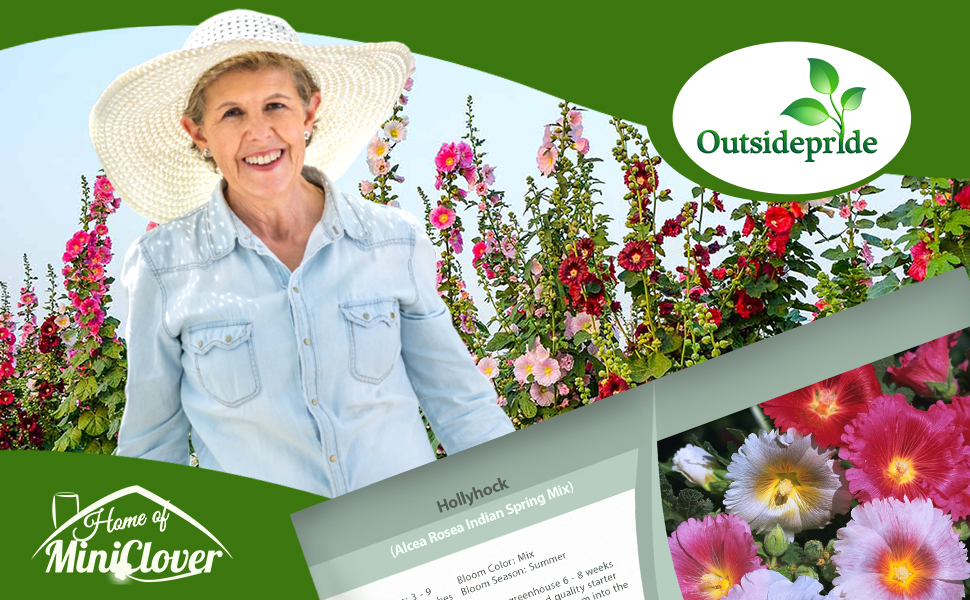
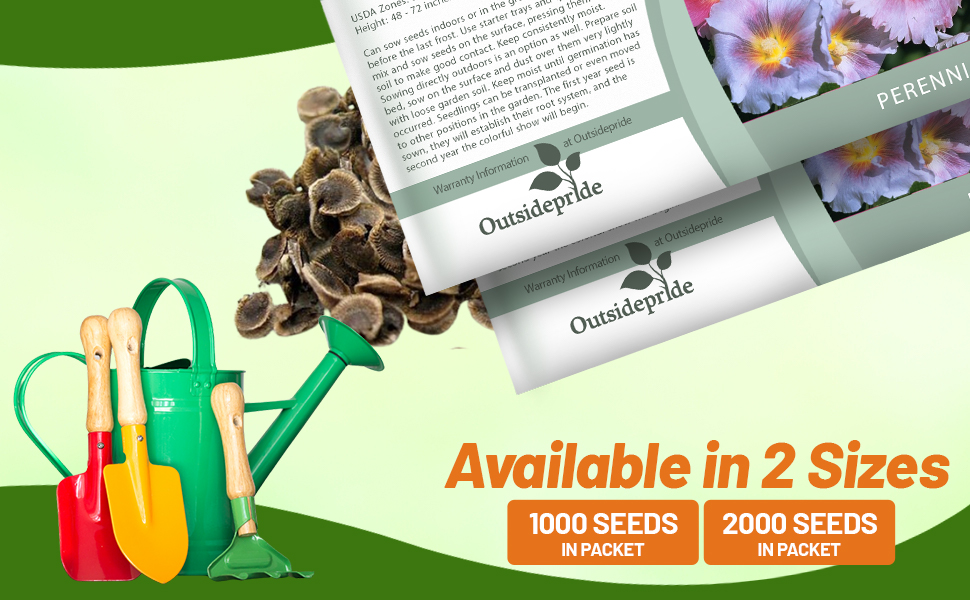
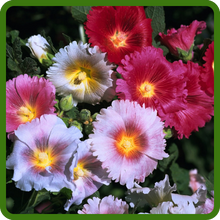
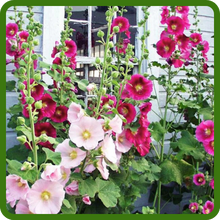
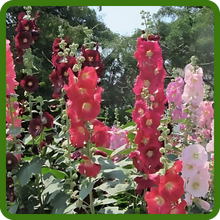


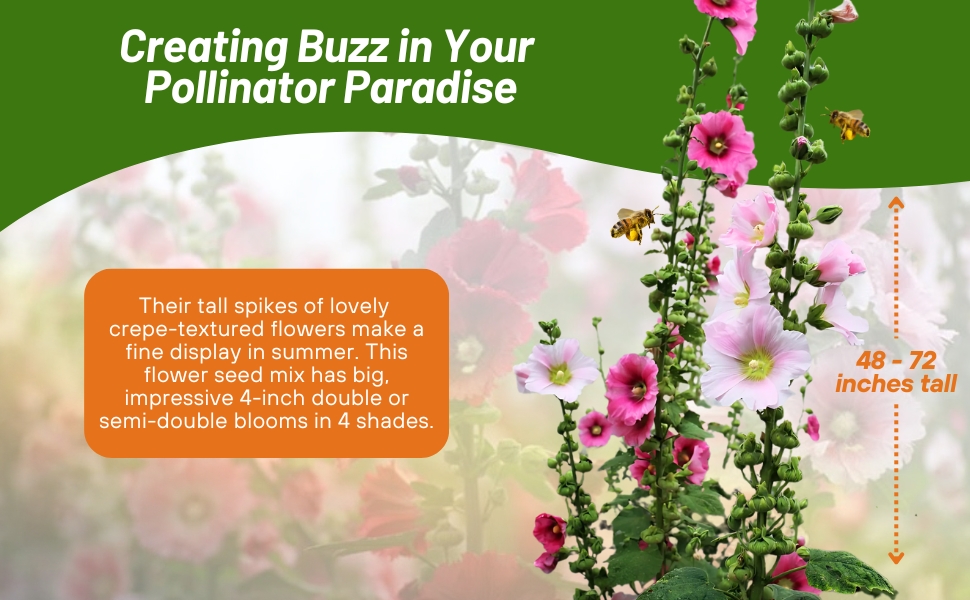
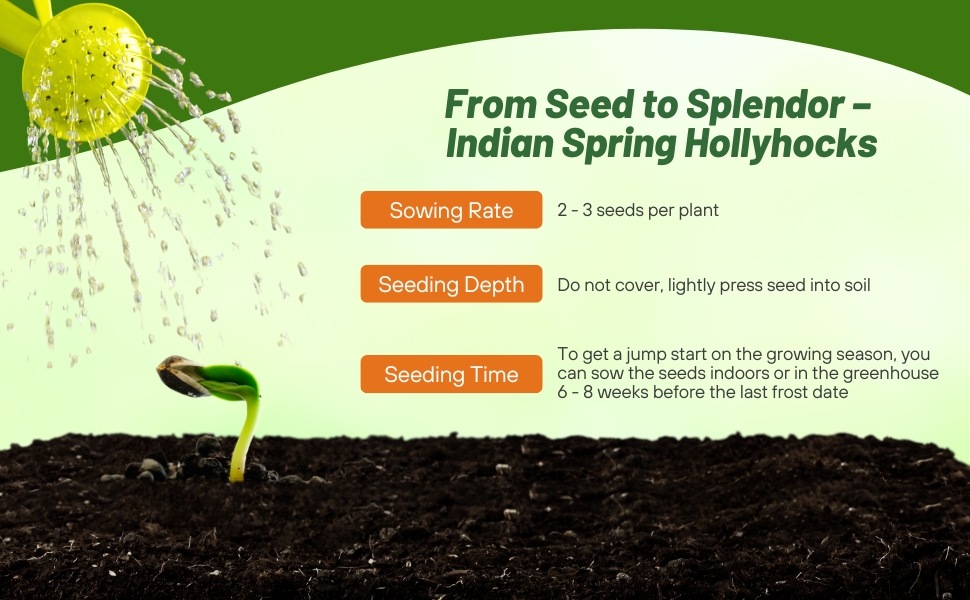
Hollyhock (Alcea Rosea Indian Spring Mix) - Hollyhocks have been grown in the garden for hundreds of years from flower seed. Their tall spikes of lovely crepe-textured flowers making a fine display in summer. This Indian Spring mix has big, impressive 4-inch double or semi-double blooms in 4 shades beginning low on the stalk, for even more color on every hollyhock plant. The flowers arise all along tall, sturdy stalks beginning just 4 months from sowing! This annual hollyhock is a long-blooming, very colorful series so garden-worthy that it has received awards. 1939 AAS Flower Winner.
Common Questions
Are hollyhocks hard to grow?
Hollyhocks are low-maintenance and easy to grow. They just need fertile soil, plenty of sun, and appropriate spacing and moisture levels to prevent problems with the fungal disease rust.
My hollyhock plants have a sickly appearance, what should I do?
If your hollyhocks appear stunted and feeble, they may be affected by the Puccinia malvacearum rust disease. This disease manifests as yellow or orange spots on the leaves, which later develop into lumps, causing the foliage to wither and fall off. Promptly eliminate the infected plants and dispose of them securely in a sealed bag.
My hollyhock’s leaves are curling, what is wrong?
Curling hollyhock leaves could indicate that the plant is under heat stress due to intense sunlight. To remedy this, consider relocating the plants to a shadier spot or installing a shade cloth for protection. Additionally, adding mulch to the soil can help maintain cooler roots for the plant.
Do I need to deadhead my hollyhock flowers?
Yes, to prolong your bloom season you will need to deadhead spent flowers. Also keeping your plants consistently moist will help encourage a good bloom season.
What are some good companion plants for alcea?
Plants such as salvia, echinacea and shasta daisy all work well with the alcea hollyhock plants.
Planting Directions
TEMPERATURE
60 - 65F
AVERAGE GERM TIME
21 - 28 days
LIGHT REQUIRED
Yes
DEPTH
Do not cover the seed but press into the soil
SOWING RATE
2 - 3 seeds per plant
MOISTURE
Keep seeds moist until germination
PLANT SPACING
24 inches
Hollyhock (Alcea Rosea Chaters Double Salmon Pink) - Large stems hold 3 - 4 inch double blooms in peachy pink tones that add height to the back of garden beds in summer through fall. Hollyhocks sow freely so don’t be surprised if plants spread and bloom for years to come. Blooms are especially attractive to bees and other pollinators and are edible. Plants can be grown in hot climates and are deer resistant. It will bloom from early to midsummer reaching a height of 5 to 7 feet tall and 1 to 2 feet wide and grows best in full sun.
Plant hollyhocks in a Cottage Garden or as a back border in a perennial garden. They have an impressive effect when planted in a mass planting. Hummingbirds, butterflies and bees are attracted to the flowers and deer tend to stay away from Hollyhocks. It has no real change in fall color and it will die back for the winter.



























